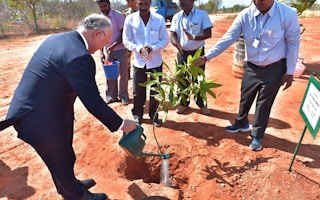A drive to plant trees and conserve areas for wildlife is triggering conflicts over land in India, with poor villagers and indigenous people most at risk of losing their homes and livelihoods, researchers warned on Friday.
India is aiming to increase its forest area and green cover to a third of its total land area by 2030, up from about a quarter, as part of its commitment to reduce carbon emissions and meet pledges made under the Paris climate accord.
Many of India’s tree planting programmes are in areas where indigenous communities have traditional land rights, according to a report by New Delhi-based research organisation Land Conflict Watch (LCW).
While infrastructure such as roads and ports are a leading cause for disputes, “conflicts have emerged from unexpected economic activities, such as the state’s conservation and forestry initiatives”, said Kumar Sambhav Shrivastava, LCW’s co-founder.
“Marginalised communities - such as tribes and those living in resource-rich areas - are disproportionately impacted by land and resource conflicts,” he told the Thomson Reuters Foundation.
There are at least 703 ongoing land conflicts across India, affecting more than 6.5 million people and covering over 2.1 million hectares of land, LCW’s research showed.
More than two-thirds of the disputes relate to common lands, including forests and grazing lands.
Compared to private land, common lands are often owned and managed by communities and villagers who do not have individual titles.
Although the constitution, the Forest Rights Act, and other legislation recognise the traditional rights of communities over forests and common lands, many states have rejected their claims or not sought their consent for developments.
“
Marginalised communities - such as tribes and those living in resource-rich areas - are disproportionately impacted by land and resource conflicts.
Kumar Sambhav Shrivastava, co-founder, Land Conflict Watch
The Forest Rights Act is being challenged in the country’s highest court, with millions facing eviction.
“It has not been easy to enforce these beneficial legislations as effectively as intended,” said Namita Wahi, a fellow at the Centre for Policy Research, a think tank in Delhi.
“The state has no interest in enforcing these laws to protect people’s rights when it limits the powers that they have exercised for so long” over constitutionally-protected areas and forests, she said.
State governments have started banking land for tree planting schemes, typically common lands over which there are no clear titles, the LCW report said.
Such land banks are usually made up of land that was initially set aside for industrial and infrastructure projects. When these projects were shelved, states kept the land for potential future use rather than return them to communities.
“Once the land is banked, it becomes even more difficult for communities to claim rights over it,” Shrivastava said.
As their populations expand, states have to juggle the needs of industries, investors, developers and vulnerable citizens, said Nikita Sud, an associate professor at Oxford University.
To powerful industries and investors, a forest or grassland is usually seen as a resource that can be used to aid economic growth, she said.
“Push comes to shove, it is the demands of dominant groups that are given primacy in state policy and practice,” she said.
This story was published with permission from Thomson Reuters Foundation, the charitable arm of Thomson Reuters, that covers humanitarian news, climate change, resilience, women’s rights, trafficking and property rights. Visit http://news.trust.org/climate.










